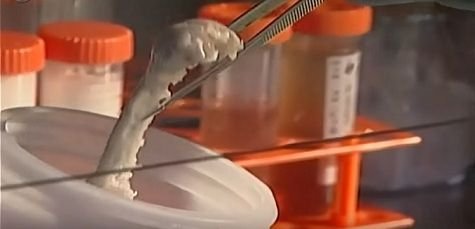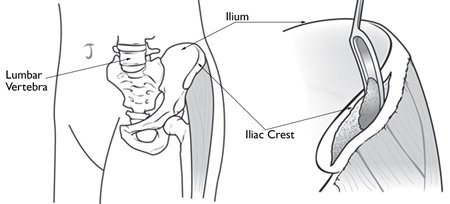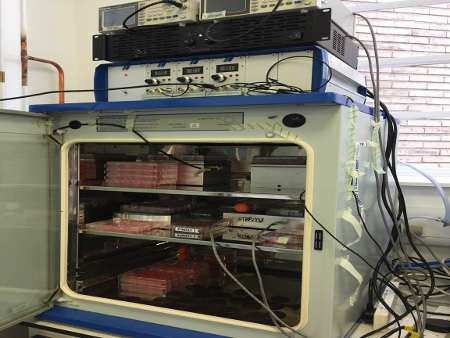Bone fracture is one thing that we may have experienced, or have seen someone experience. I, particularly, have experienced quite a number of these. And amazingly, bones have the ability to heal themselves, as long as they are well positioned together; maybe held by a cast; so that it would form calluses and heal naturally.
This is because, bones are made up of living tissues. And the fact is; bones, as it were, are regularly breaking down and re-modelling themselves, to suite some necessary conditions (this is explained in Wolff's law).
But what happens when the bone suffers from extensive trauma that may make them practically impossible to heal? Well, that is where the advances and emerging technologies in biomedical engineering will take full course. I welcome us to the era of Customized Lab-grown bones.

Medieval bone fixing techniques
Before we proceed with this emerging technology, we shall consider briefly the ways by which extensively damaged bones were fixed before the advent of "lab-grown bone".
The four most popular options include:
- From animals: This is called "xenotransplantation", where part of the bones of some selected animals are snapped and used to fix a damaged human bone.
- From moribund: Yes! Bones can be harvested from donors at the point of death of even from cadavers to be used as transplant alternatives for fixing of bones.
- Metal implant: In this process, a metal is used to replace the damaged part. And one of the most widely used metals is the Titanium alloy.
- Harvesting bone from your own body: In this process, bones from some parts of your body, particularly your iliac crest (in the hip bone) are harvested and used to reconstruct the bones that were damaged (more like bone grafting).

But these cases pose some degrees of risks to the patient. Rejection in the first two options can occur. Then, for the fourth option, it is just as scary as it sounds, plus the unimaginable pains the patient has to undergo. Then all the four options still pose the risk of infection.
That is why scientists have; as a matter of urgency to preserve lives; sought out for better alternatives, and this is tissue engineering.
Engineering of bone
Ever heard of lab-grown organ? Well, I guess we may have heard of it; but Biomedical Engineers have finally figured out a way of growing human bones from the patient’s own cells. Fascinating, right?
This trail was blazed by a combined team of researchers from university of Glasgow, and University of Strathclyde, led by Professor Stuart Reid (Biomedical Engineering).
Here's the mechanics behind growing of bones in the lab:
The first step is to take a CT scan of the damaged bone, and use a 3D printer of make a "negative" copy of the bone. This would serve as a scaffold for the engineering process. Then a stemcell would be harvested from the patient's body (we all know that a stem cell can be tailored to perform any function).
The next step is to incorporate the stemcell in the scaffold and leave in a bioreactor to culture for a period of time (a bioreactor actually simulates the biological conditions of the body, and also adds the necessary nutrients).

Once the bone is fully grown, it would be exteriorized from the bioreactor and transplanted to the patient’s body. And yes! It would be as natural as the biological bone.
Also, during the process of incubation, tiny vibrations would be sent in occasionally, to integrate the minerals in the bioreactor inside the bone. A new bioreactor, known as "nanokick", co-invented by Dr Peter Childs is the most ideal for this, because you can actually pre-program the frequency of the vibrations (in Hertz).
Here's a little video I got from “CNBC live” YouTube account on how this process works.
Potential benefits of this tech
No doubt, this is set to revolutionize reconstructive surgery, as it would restore hope to people with extensively damaged bones.
Also, there is almost a zero chance of the body rejecting the bone. This is due to the fact that the bone is grown totally from the patient's own stemcell. Also, I won't have you ignorant of this fact by Professor Stuart Reid:
The human body is a Vast Renewable Resource. - Professor Stuart [Paraphrased by me]
If this is so, then it is totally possible to re-grow almost any part of the human body. Maybe one day we could achieve immortality this way, by changing our individual body parts over time to stay longer. Time will tell.
Thanks for reading
References for further reading: Ref1, Ref2, Ref3, Ref4, Ref4


gif by @foundation
This is a test comment, notify @kryzsec on discord if there are any errors please.
Being A SteemStem Member
Downvoting a post can decrease pending rewards and make it less visible. Common reasons:
Submit
I'm really honoured
Downvoting a post can decrease pending rewards and make it less visible. Common reasons:
Submit
is incredible as science is already rising in level and evolution, and many technologies are being developed so that the human being does not deteriorate over time, everything pro has its counter.
all that technology is used for good, the human race has always sought its excitement, the developments are already reaching their maximum level and waiting for the receptivity of ourselves ... good data and very interesting your publications
Downvoting a post can decrease pending rewards and make it less visible. Common reasons:
Submit
Thanks for dropping by
Downvoting a post can decrease pending rewards and make it less visible. Common reasons:
Submit